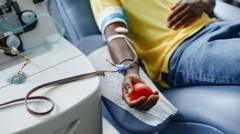In a landmark move, Australia will eliminate its longstanding ban limiting blood and plasma donations from gay and bisexual men next month, signaling a shift toward inclusivity. These regulations were originally put in place to mitigate the risk of HIV transmission but are now being revised, aligning with recent changes in the UK and US.
Approved by the health products regulator, new guidelines announced by Lifeblood eliminate previous stipulations that barred men or transgender women from donating if they had sex with men in the past three months. Instead, individuals involved in a sexual relationship with a single partner for at least six months, regardless of gender or sexuality, will be permitted to donate.
Health advocates, including Rodney Croome from the Let Us Give campaign, emphasized that this change is crucial for the well-being of the Australian LGBTQIA+ community and represents a significant step towards combating stigma faced by these groups. Lifeblood's Chief Medical Officer, Jo Pink, acknowledged the longstanding challenges imposed by the old rules.
While the new criteria eliminate questions regarding sexual activity with men in the prior three months, they introduce a new query about having anal sex with either new or multiple partners. Those answering affirmatively will need to wait three months before donating blood; however, they will still be able to donate plasma. Additionally, individuals on the HIV prevention medication PrEP will also be allowed to donate plasma, but not whole blood.
Research from Lifeblood in collaboration with Sydney's University of New South Wales indicates that these changes will not compromise blood safety. The decisions come amid an increasing global demand for plasma, which is critical for several medical treatments.
Despite the positive reception, some observers, such as researcher Sharon Dane from Let Us Give, flagged the ongoing restrictions as less progressive compared to nations like Canada and the UK, where the waiting period for blood donation is shorter. The actual adjustments, particularly concerning blood donations, are scheduled for implementation in 2026, while plasma donations are set to commence on July 14.
Approved by the health products regulator, new guidelines announced by Lifeblood eliminate previous stipulations that barred men or transgender women from donating if they had sex with men in the past three months. Instead, individuals involved in a sexual relationship with a single partner for at least six months, regardless of gender or sexuality, will be permitted to donate.
Health advocates, including Rodney Croome from the Let Us Give campaign, emphasized that this change is crucial for the well-being of the Australian LGBTQIA+ community and represents a significant step towards combating stigma faced by these groups. Lifeblood's Chief Medical Officer, Jo Pink, acknowledged the longstanding challenges imposed by the old rules.
While the new criteria eliminate questions regarding sexual activity with men in the prior three months, they introduce a new query about having anal sex with either new or multiple partners. Those answering affirmatively will need to wait three months before donating blood; however, they will still be able to donate plasma. Additionally, individuals on the HIV prevention medication PrEP will also be allowed to donate plasma, but not whole blood.
Research from Lifeblood in collaboration with Sydney's University of New South Wales indicates that these changes will not compromise blood safety. The decisions come amid an increasing global demand for plasma, which is critical for several medical treatments.
Despite the positive reception, some observers, such as researcher Sharon Dane from Let Us Give, flagged the ongoing restrictions as less progressive compared to nations like Canada and the UK, where the waiting period for blood donation is shorter. The actual adjustments, particularly concerning blood donations, are scheduled for implementation in 2026, while plasma donations are set to commence on July 14.



















